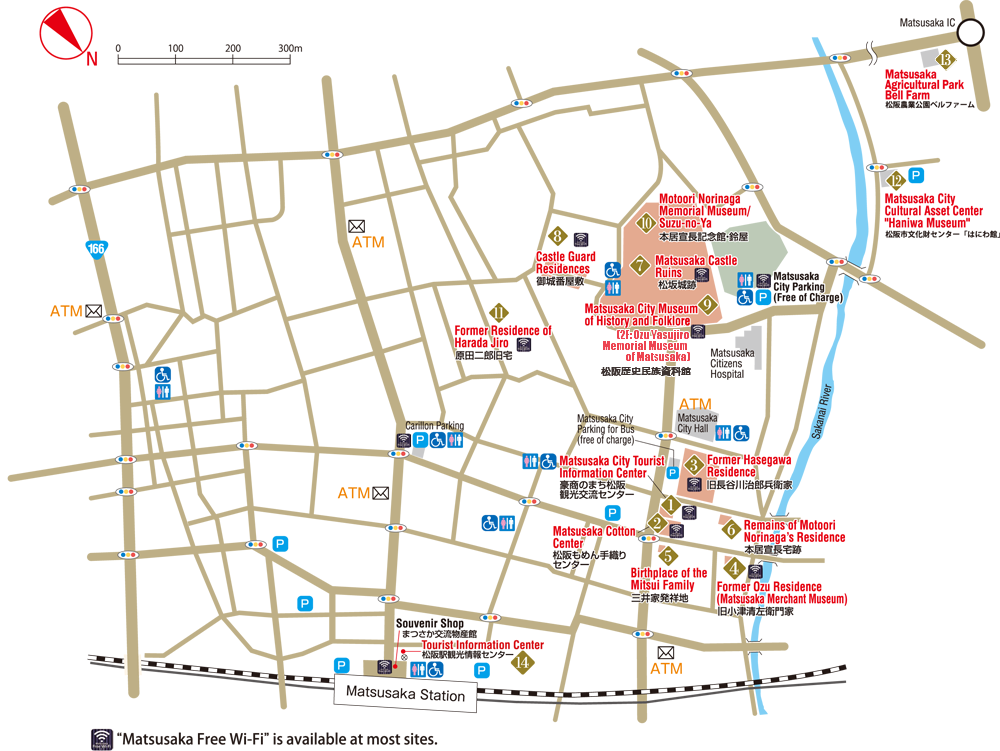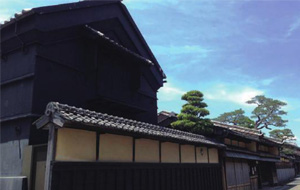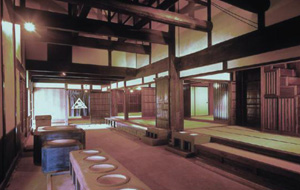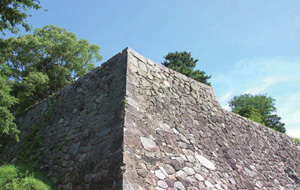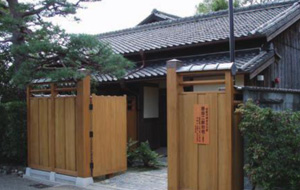
-
On the first floor you can get information on sightseeing and places to eat in Matsusaka. There are also many souvenirs and special products of Matsusaka for sale. The second floor introduces the history of Matsusaka through a video playing in the theatre room (with English subtitles) and an exhibit of informational panels. This facility is a great place to start exploring Matsusaka City.
-
This center works to produce and hand down knowledge about the traditional handicraft Matsusaka Cotton. Fabric, kimono, and accessories on sale all feature a beautiful indigo striped pattern, and make excellent souvenirs. Also popular with customers is the authentic Edo-period loom, where you can hand-weave original pieces.
-
The Hasegawa family made its fortune as cotton merchants in Edo (now Tokyo). The estate features historical architecture such as wooden lattices, five storehouses, and a roof supported by a distinctive udatsu beam—one of only three remaining in Mie Prefecture. Centered around a pond and full of beautiful greenery, the garden is a pleasure to visit in all seasons. Items on display include tools preserved by the family over the years and a recently discovered collection of golden coins.
more info>>
-
This is the former residence of Ozu Seizaemon, a successful merchant who traded paper and cotton on a large scale in Edo (now Tokyo). Despite the simple exterior with wooden lattices and a bamboo fence, the site is surprisingly spacious and two mud-walled storehouses are preserved within. It also features a rare, huge money chest. It is a great place to learn about the lives of the Matsusaka merchants who ran stores in Edo.
more info>>
-
Mitsui Takatoshi, the great merchant who established the foundation for the Mitsui zaibatsu (a conglomerate of companies), was born in the city of Matsusaka. Although this site is not open to the public, it contains a memorial to the birthplace of the family and the well which was used to give Takatoshi his first bath as a newborn.
-
The former site of Norinaga’s residence “Suzu-no-ya”, which was relocated to a location adjacent to the Motoori Norinaga Memorial Museum, contains Norinaga’s beloved garden pines, the residence’s foundation stone, a stone monument, and the home of Norinaga’s son Haruniwa. During Norinaga’s time, the homes of Matsusaka merchants stood side by side around his residence. Walk in this area and you will be transported back through time to Matsusaka of two hundred years ago.
-
Matsusaka Castle was built in 1588 by the military commander Gamo Ujisato. The original castle tower was lost in a typhoon long ago, but the impressive stone walls remain and earned Matsusaka a spot in Japan’s Top 100 Castles. The site is well known among locals as a great place to relax and enjoy the scenery. Visitors can look forward to plum, cherry, and wisteria blossoms in spring and gingko leaves turning gold in autumn.
more info>>
-
These residences were home to samurai warriors of the Kishu Domain who guarded Matsusaka Castle at the end of the Edo period (1603-1868). Unusually for such a site, people continue to live here to this day, and it has received national designation as an Important Cultural Property. One of the houses is open to the public.
-
This historical building was originally built to serve as a library in 1911. On the 1st floor is the exhibit of materials related to Matsusaka merchants and their wares. On the 2nd floor is the exhibit of Ozu Yasujiro, the world-renowned film director.
-
Motoori Norinaga (1730-1801) was an Edo period researcher of classic Japanese literature such as Kojiki and The Tale of Genji. The Motoori Norinaga Museum features Norinaga’s former residence “Suzu-no-ya,” original manuscripts, self-portraits, and Norinaga’s favorite bells. ("Suzu-no-Ya" means "House of Bells.")
-
Harada Jiro (1849-1930) was a financial advisor active from the Meiji through the Taisho period. He used all of his personal assets to establish a foundation for public welfare. His home is located in the middle of town, a historic area where samurai residences once stood side by side. The building preserves the style of architecture commonly used for homes of samurai in the Edo period.
more info>>
-
There is a permanent exhibit of haniwa (clay figures used in ancient funerals) excavated at the Takarazuka burial mound. One of the haniwa is shaped like a ship, and is the largest of its kind in Japan. This and other artifacts have been designated as Important Cultural Properties of Japan. The redbrick warehouse built close to 100 years ago houses a gallery, and is used for city residents artistic activities.
-
Featuring a barbecue restaurant that serves Matsusaka beef, a café that uses local ingredients, fresh fruit and vegetables, a souvenir store, agriculture- and food-related events, indoor and outdoor gardens that showcase seasonal plants, and expansive grounds that include plenty of room for large buses to park, Bell Farm brims with a variety of charms.
-
If you come to Matsusaka by train, don’t fail to drop in at Matsusaka Station Tourist Information Center. All kinds of tourist information of our city is here. Rental bicycle, wheelchair and baggage service are also available. We can help you to rent a car as well. On the second floor is a small cozy cafeteria.

Copyright © 2024 Matsusaka City Tourism Association All rights reserved

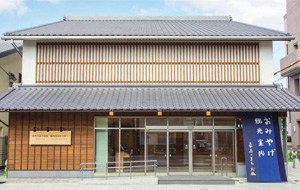 On the first floor you can get information on sightseeing and places to eat in Matsusaka. There are also many souvenirs and special products of Matsusaka for sale. The second floor introduces the history of Matsusaka through a video playing in the theatre room (with English subtitles) and an exhibit of informational panels. This facility is a great place to start exploring Matsusaka City.
On the first floor you can get information on sightseeing and places to eat in Matsusaka. There are also many souvenirs and special products of Matsusaka for sale. The second floor introduces the history of Matsusaka through a video playing in the theatre room (with English subtitles) and an exhibit of informational panels. This facility is a great place to start exploring Matsusaka City.
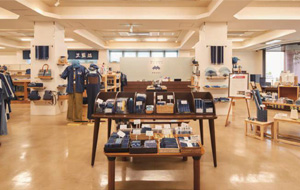 This center works to produce and hand down knowledge about the traditional handicraft Matsusaka Cotton. Fabric, kimono, and accessories on sale all feature a beautiful indigo striped pattern, and make excellent souvenirs. Also popular with customers is the authentic Edo-period loom, where you can hand-weave original pieces.
This center works to produce and hand down knowledge about the traditional handicraft Matsusaka Cotton. Fabric, kimono, and accessories on sale all feature a beautiful indigo striped pattern, and make excellent souvenirs. Also popular with customers is the authentic Edo-period loom, where you can hand-weave original pieces. The Hasegawa family made its fortune as cotton merchants in Edo (now Tokyo). The estate features historical architecture such as wooden lattices, five storehouses, and a roof supported by a distinctive udatsu beam—one of only three remaining in Mie Prefecture. Centered around a pond and full of beautiful greenery, the garden is a pleasure to visit in all seasons. Items on display include tools preserved by the family over the years and a recently discovered collection of golden coins. more info>>
The Hasegawa family made its fortune as cotton merchants in Edo (now Tokyo). The estate features historical architecture such as wooden lattices, five storehouses, and a roof supported by a distinctive udatsu beam—one of only three remaining in Mie Prefecture. Centered around a pond and full of beautiful greenery, the garden is a pleasure to visit in all seasons. Items on display include tools preserved by the family over the years and a recently discovered collection of golden coins. more info>> This is the former residence of Ozu Seizaemon, a successful merchant who traded paper and cotton on a large scale in Edo (now Tokyo). Despite the simple exterior with wooden lattices and a bamboo fence, the site is surprisingly spacious and two mud-walled storehouses are preserved within. It also features a rare, huge money chest. It is a great place to learn about the lives of the Matsusaka merchants who ran stores in Edo. more info>>
This is the former residence of Ozu Seizaemon, a successful merchant who traded paper and cotton on a large scale in Edo (now Tokyo). Despite the simple exterior with wooden lattices and a bamboo fence, the site is surprisingly spacious and two mud-walled storehouses are preserved within. It also features a rare, huge money chest. It is a great place to learn about the lives of the Matsusaka merchants who ran stores in Edo. more info>>
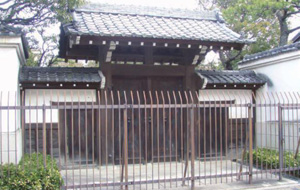 Mitsui Takatoshi, the great merchant who established the foundation for the Mitsui zaibatsu (a conglomerate of companies), was born in the city of Matsusaka. Although this site is not open to the public, it contains a memorial to the birthplace of the family and the well which was used to give Takatoshi his first bath as a newborn.
Mitsui Takatoshi, the great merchant who established the foundation for the Mitsui zaibatsu (a conglomerate of companies), was born in the city of Matsusaka. Although this site is not open to the public, it contains a memorial to the birthplace of the family and the well which was used to give Takatoshi his first bath as a newborn.
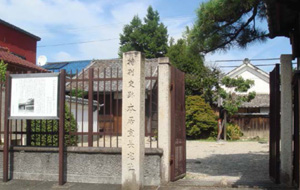 The former site of Norinaga’s residence “Suzu-no-ya”, which was relocated to a location adjacent to the Motoori Norinaga Memorial Museum, contains Norinaga’s beloved garden pines, the residence’s foundation stone, a stone monument, and the home of Norinaga’s son Haruniwa. During Norinaga’s time, the homes of Matsusaka merchants stood side by side around his residence. Walk in this area and you will be transported back through time to Matsusaka of two hundred years ago.
The former site of Norinaga’s residence “Suzu-no-ya”, which was relocated to a location adjacent to the Motoori Norinaga Memorial Museum, contains Norinaga’s beloved garden pines, the residence’s foundation stone, a stone monument, and the home of Norinaga’s son Haruniwa. During Norinaga’s time, the homes of Matsusaka merchants stood side by side around his residence. Walk in this area and you will be transported back through time to Matsusaka of two hundred years ago. Matsusaka Castle was built in 1588 by the military commander Gamo Ujisato. The original castle tower was lost in a typhoon long ago, but the impressive stone walls remain and earned Matsusaka a spot in Japan’s Top 100 Castles. The site is well known among locals as a great place to relax and enjoy the scenery. Visitors can look forward to plum, cherry, and wisteria blossoms in spring and gingko leaves turning gold in autumn. more info>>
Matsusaka Castle was built in 1588 by the military commander Gamo Ujisato. The original castle tower was lost in a typhoon long ago, but the impressive stone walls remain and earned Matsusaka a spot in Japan’s Top 100 Castles. The site is well known among locals as a great place to relax and enjoy the scenery. Visitors can look forward to plum, cherry, and wisteria blossoms in spring and gingko leaves turning gold in autumn. more info>>
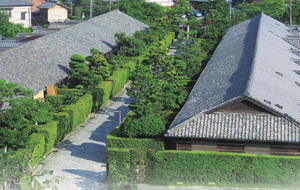 These residences were home to samurai warriors of the Kishu Domain who guarded Matsusaka Castle at the end of the Edo period (1603-1868). Unusually for such a site, people continue to live here to this day, and it has received national designation as an Important Cultural Property. One of the houses is open to the public.
These residences were home to samurai warriors of the Kishu Domain who guarded Matsusaka Castle at the end of the Edo period (1603-1868). Unusually for such a site, people continue to live here to this day, and it has received national designation as an Important Cultural Property. One of the houses is open to the public.
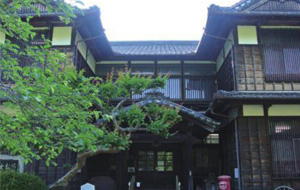 This historical building was originally built to serve as a library in 1911. On the 1st floor is the exhibit of materials related to Matsusaka merchants and their wares. On the 2nd floor is the exhibit of Ozu Yasujiro, the world-renowned film director.
This historical building was originally built to serve as a library in 1911. On the 1st floor is the exhibit of materials related to Matsusaka merchants and their wares. On the 2nd floor is the exhibit of Ozu Yasujiro, the world-renowned film director.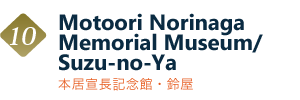
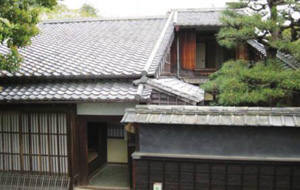 Motoori Norinaga (1730-1801) was an Edo period researcher of classic Japanese literature such as Kojiki and The Tale of Genji. The Motoori Norinaga Museum features Norinaga’s former residence “Suzu-no-ya,” original manuscripts, self-portraits, and Norinaga’s favorite bells. ("Suzu-no-Ya" means "House of Bells.")
Motoori Norinaga (1730-1801) was an Edo period researcher of classic Japanese literature such as Kojiki and The Tale of Genji. The Motoori Norinaga Museum features Norinaga’s former residence “Suzu-no-ya,” original manuscripts, self-portraits, and Norinaga’s favorite bells. ("Suzu-no-Ya" means "House of Bells.") Harada Jiro (1849-1930) was a financial advisor active from the Meiji through the Taisho period. He used all of his personal assets to establish a foundation for public welfare. His home is located in the middle of town, a historic area where samurai residences once stood side by side. The building preserves the style of architecture commonly used for homes of samurai in the Edo period. more info>>
Harada Jiro (1849-1930) was a financial advisor active from the Meiji through the Taisho period. He used all of his personal assets to establish a foundation for public welfare. His home is located in the middle of town, a historic area where samurai residences once stood side by side. The building preserves the style of architecture commonly used for homes of samurai in the Edo period. more info>>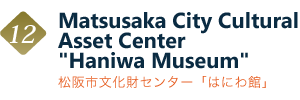
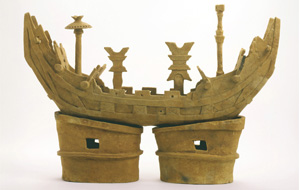 There is a permanent exhibit of haniwa (clay figures used in ancient funerals) excavated at the Takarazuka burial mound. One of the haniwa is shaped like a ship, and is the largest of its kind in Japan. This and other artifacts have been designated as Important Cultural Properties of Japan. The redbrick warehouse built close to 100 years ago houses a gallery, and is used for city residents artistic activities.
There is a permanent exhibit of haniwa (clay figures used in ancient funerals) excavated at the Takarazuka burial mound. One of the haniwa is shaped like a ship, and is the largest of its kind in Japan. This and other artifacts have been designated as Important Cultural Properties of Japan. The redbrick warehouse built close to 100 years ago houses a gallery, and is used for city residents artistic activities.
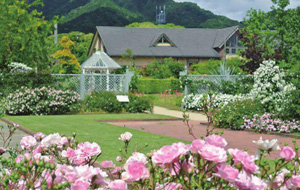 Featuring a barbecue restaurant that serves Matsusaka beef, a café that uses local ingredients, fresh fruit and vegetables, a souvenir store, agriculture- and food-related events, indoor and outdoor gardens that showcase seasonal plants, and expansive grounds that include plenty of room for large buses to park, Bell Farm brims with a variety of charms.
Featuring a barbecue restaurant that serves Matsusaka beef, a café that uses local ingredients, fresh fruit and vegetables, a souvenir store, agriculture- and food-related events, indoor and outdoor gardens that showcase seasonal plants, and expansive grounds that include plenty of room for large buses to park, Bell Farm brims with a variety of charms.
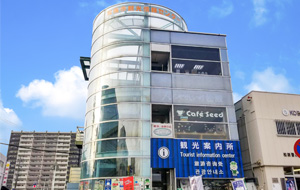 If you come to Matsusaka by train, don’t fail to drop in at Matsusaka Station Tourist Information Center. All kinds of tourist information of our city is here. Rental bicycle, wheelchair and baggage service are also available. We can help you to rent a car as well. On the second floor is a small cozy cafeteria.
If you come to Matsusaka by train, don’t fail to drop in at Matsusaka Station Tourist Information Center. All kinds of tourist information of our city is here. Rental bicycle, wheelchair and baggage service are also available. We can help you to rent a car as well. On the second floor is a small cozy cafeteria.












